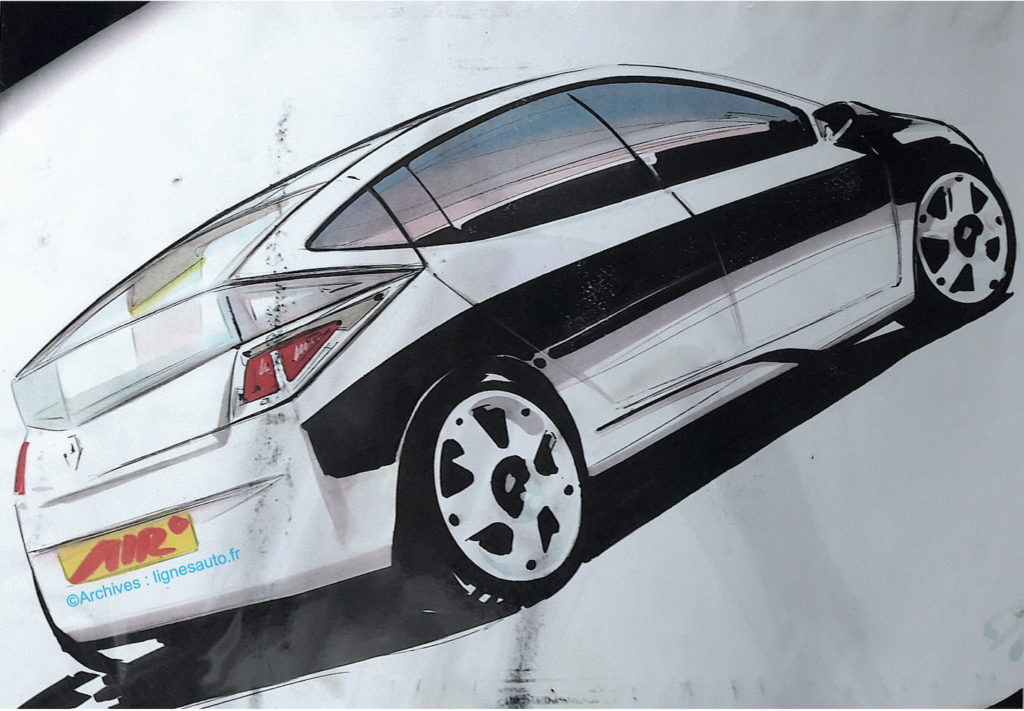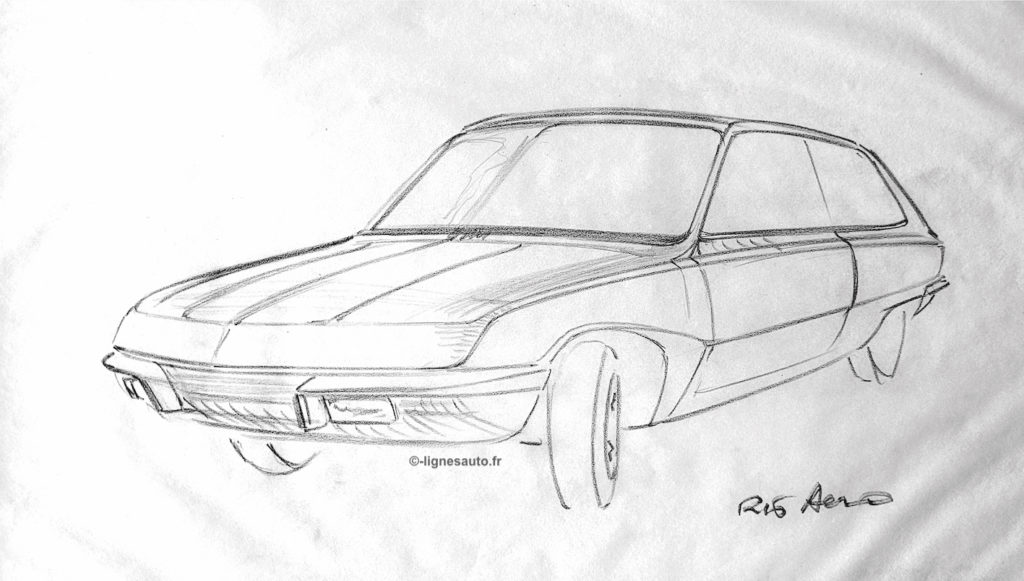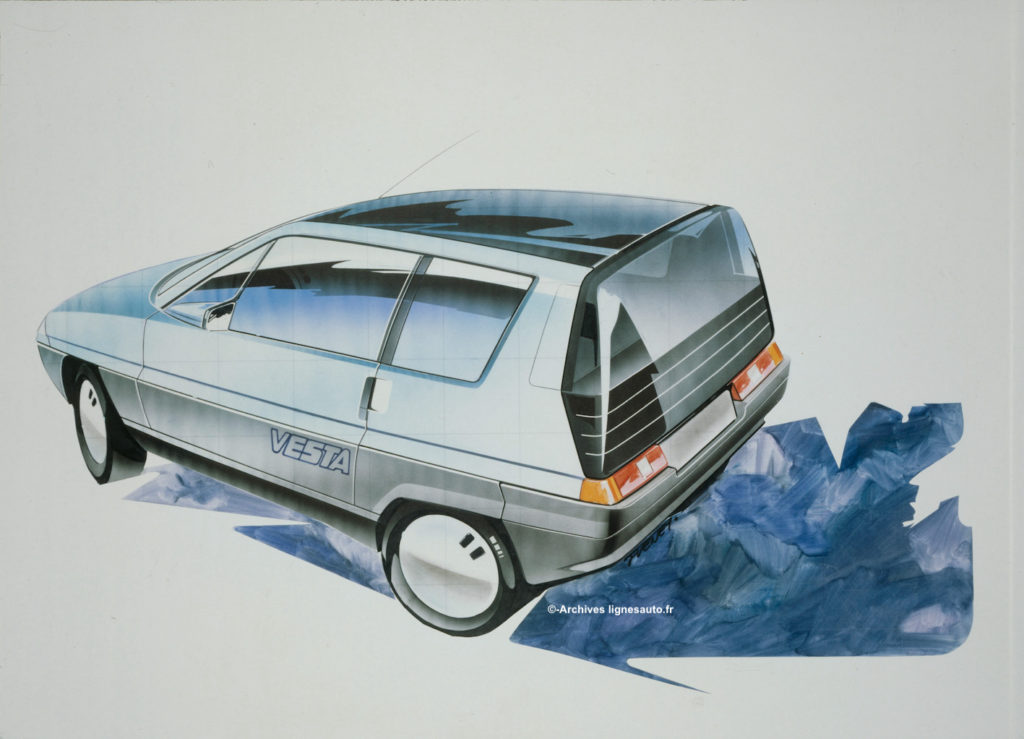

Here are some exclusive documents dating back to early 1998, during the study of the Renault W84 project that gave birth to the highly original Mégane II in 2002. The project director was Carlos Tavares himself, while design was managed by Patrick le Quément.

While the saloon that was finally chosen, along with its coupé, cabriolet, estate, Scénic and Scénic long MPV sisters, and finally the tricoprs (what a family!) are all well known, there is one study derivative that never saw the light of day, but which shows just how many ideas Renault’s research and design departments were teeming with at the time. This study focused primarily on aerodynamic efficiency, which obviously had an impact on design. Why talk about it today? Because with the advent of electric vehicles, we have the impression that it is the latter that have given new life to the ultimate aerodynamic research, in order to gain one, two or even ten extra kilometres of range before plugging the EV into a life-saving socket.

No, the electric car is obviously not the only one to have opened up this aerodynamic chapter. Even in the prehistoric era of internal combustion cars (!), this was a fundamental issue. Renault was one of the pioneers in this field, even if it was not alone, starting with Citroën.

Let’s not forget that Citroën’s design director in the 1960s – Robert Opron – explained that the weakness of the engines meant that he had to design aerodynamic cars to achieve good performance. The aptly named CX is just one example! And, in Germany, the series of wind-smoothed Audis, designed by Ferdinand Piëch with the advent of the famous flush-fitting windows in the early 1980s.

Renault, for its part, has developed several concepts or studies on this theme (see the BONUSES at the end of this post). In 1998, the aim was to offer a compact saloon in the C segment – the most buoyant segment in Europe at the time – with a Cx coefficient of just 0.30. A target that one of the people in charge felt was “very high, given that current forecasts for the W84 project are between 0.32 and 0.36”. The team set up for this programme is led by Anne Asensio, and the designer affiliated to this study is Axel Breun.

In 1998, digital technology had evolved considerably since the little computer-generated film of the Racoon concept car five years earlier, and it was natural to find a multitude of digitised drawings trying to reach the 0.30 threshold. For the record, the Cx of the Mégane II saloon marketed in 2002 was 0.35.

Alongside the digital drawings, small-scale models were produced and refined in the wind tunnel. Initially, the results fell far short of the initial objective. Mr Genty’s department, which was involved in this work, decided that “the objective could not be achieved without concessions” and therefore suggested “accentuating the narrower rear section and lengthening the rear overhang”. Design was directly involved.

The service also stresses the “importance of adopting an optimised smooth floor” known as P2 type, without which the SCx will be even higher. However, the memo states that “no competing vehicle in this segment is the target of the W84 AIR-O project”. Axel Breun refined his drawings and model. The Cx then fell below 0.35 for the production saloon and was compared with what the competition was offering. For example, it is noted that “the Toyota Corolla was announced in the press with a low Cx of 0.31”, a vehicle that was immediately tested in Renault’s wind tunnel and “it turns out that the measurements give an SCx of 0.680 and a Cx of 0.35”.

The study of the AIR-O concept continues with a constant reminder of figures that are always good to remember: “It’s important to remember some of the consequences of SCx on fuel consumption at high speed, but also on Vmax. and acceleration. There are significant differences between a Cx of 0.35 and a Cx of 0.32”. This range seems to have been reached by the AIR-O study.

The project’s aerodynamics manager goes on to say that “a variation in SCx of 0.010 m2 – with an SCx of around 0.620 for the AIR-O study – is equivalent to a variation in Vmax. By 1 km/h and a fuel consumption of 0.1 litre per 100 km at a speed of 160 km/h. To prove that this study pushes precision to the limit, the note specifies that “the models measured have a Vmax error of 2.5 to 7.5 km/h. compared with a vehicle with an SCx target, this means extra consumption of between 0.3 and 0.75 litres per 100 km.

And everything goes wrong when the conclusions of the first tests state that “the choice of dimensions cannot be independent of the choice of other features such as fuel consumption or Vmax. It is therefore important for the product to make its choices known, so that priorities can be established in terms of aerodynamics: modification of the rear styling with a tighter, longer overhang, treatment of the rear area and P2 floor”.

But this AIR-O project for an aerodynamic study of the Mégane II was put on hold at the end of 1998. The memo went on to state that “aerodynamic work on the W84 segment mock-ups should not begin until early 1999, due to a lack of resources. To date, the model measured an SCx of 0.686 m2, giving a Cx of 0.34. Current targets in this segment are a Cx of 0.30. This figure is achievable, but at the cost of severe constraints on sizing.

Our documents and photos stop there. Did the project continue in 1999 and 2000? The fact remains that the Mégane II, with its bold design strongly inspired by that of the 1998 VelSatis concept car below left (designed by the late Florian Thiercelin), was unveiled in 2002 with a Cx only one point higher than that of the AIR-O study, which undoubtedly helped to define the aerodynamics of the final model. The Mégane II was an aesthetic and commercial success, and was voted Car of the Year 2003.

BONUS: RENAULT IN THE WIND!

In 1961, while he was busy working on project 115 for the future Renault 16, Gaston Juchet took over studies of the aerodynamic saloon from his predecessor Robert Barthaud (above and below).

At the same time, still working on the Renault 16, Gaston Juchet produced a sketch he called the “R16 Aero” (below), with a closed, sloping front end and elaborate wheel arches. Note that this is a two-door version of the R16…

Below, we are at the very end of the 1970s. Barely two years after his arrival at the Renault design office in 1977, Jean-François Venet drew up a counter-proposal as part of the X29 project for the future R25. Once again, the theme was aerodynamics, and the project took the name ‘Rafale’.

Before being built to 1:1 scale, the small model of the Renault Rafale goes through the wind tunnel under the eyes of its designer, below.

Below, the Renault EVE of the early 1980s is designed to split the air. EVE stands for Éléments pour une Voiture Économe. The car incorporates the R5 engine and gets 4.1 litres per 100 km. The Cx is 0.24!

EVE will be the subject of a further development, called EVE+ below. It was powered by a 50 bhp turbo-diesel engine and achieved a fuel consumption of 3.5 litres per 100 km, while its Cx was lowered to an exceptional 0.22 for its time. EVE and EVE+ are the result of close collaboration with the styling department and Gaston Juchet.

In 1982, when the styling of the Renault Supercinq had been frozen but the car would not be marketed until two years later, Renault proposed the VESTA: ‘Véhicule Économe de Systèmes et Technologies Avancées’, below, with the ambition of falling below 3 litres per 100 km. This objective was not initially achieved…

We had to wait until 1987 to discover the Vesta 2 below, which was completely different from the first version. Its teardrop styling gave it a lower Cx of 0.186, and its small 716cc 3-cylinder engine beat the world fuel consumption record with 1.94 litres per 100 km.

Eleven years later, the in-house W84 AIR-O programme – with no external communication ambitions, until now… – has helped to reduce the Cx of a C-segment compact car to 0.32 according to the latest documents observed… Obviously, this list of Renault aerodynamics is far from exhaustive!


